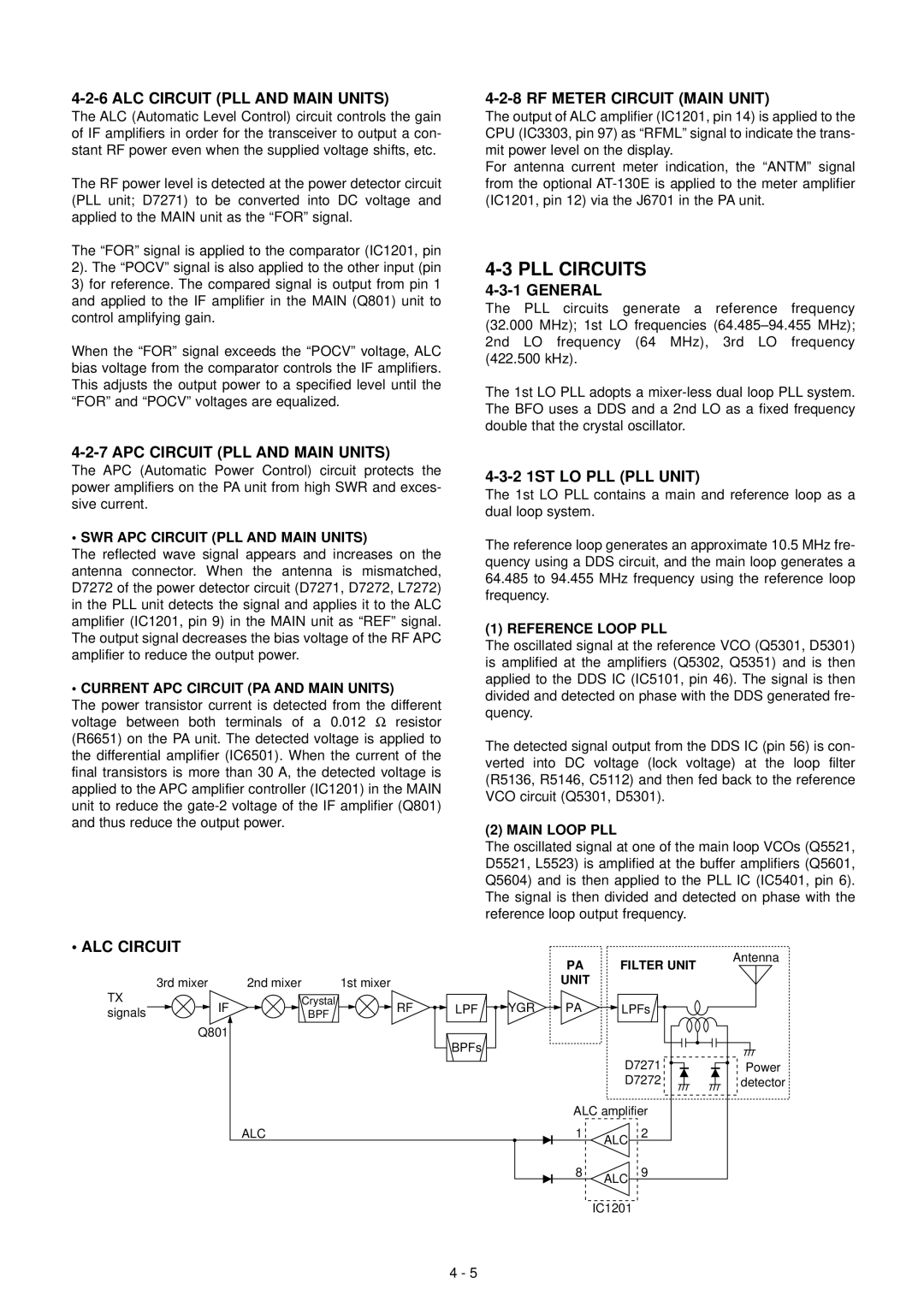
4-2-6 ALC CIRCUIT (PLL AND MAIN UNITS)
The ALC (Automatic Level Control) circuit controls the gain of IF amplifiers in order for the transceiver to output a con- stant RF power even when the supplied voltage shifts, etc.
The RF power level is detected at the power detector circuit (PLL unit; D7271) to be converted into DC voltage and applied to the MAIN unit as the “FOR” signal.
The “FOR” signal is applied to the comparator (IC1201, pin 2). The “POCV” signal is also applied to the other input (pin
3)for reference. The compared signal is output from pin 1 and applied to the IF amplifier in the MAIN (Q801) unit to control amplifying gain.
When the “FOR” signal exceeds the “POCV” voltage, ALC bias voltage from the comparator controls the IF amplifiers. This adjusts the output power to a specified level until the “FOR” and “POCV” voltages are equalized.
4-2-8 RF METER CIRCUIT (MAIN UNIT)
The output of ALC amplifier (IC1201, pin 14) is applied to the CPU (IC3303, pin 97) as “RFML” signal to indicate the trans- mit power level on the display.
For antenna current meter indication, the “ANTM” signal from the optional
4-3 PLL CIRCUITS
4-3-1 GENERAL
The PLL circuits generate a reference frequency (32.000 MHz); 1st LO frequencies
The 1st LO PLL adopts a
4-2-7 APC CIRCUIT (PLL AND MAIN UNITS)
The APC (Automatic Power Control) circuit protects the power amplifiers on the PA unit from high SWR and exces- sive current.
• SWR APC CIRCUIT (PLL AND MAIN UNITS)
The reflected wave signal appears and increases on the antenna connector. When the antenna is mismatched, D7272 of the power detector circuit (D7271, D7272, L7272) in the PLL unit detects the signal and applies it to the ALC amplifier (IC1201, pin 9) in the MAIN unit as “REF” signal. The output signal decreases the bias voltage of the RF APC amplifier to reduce the output power.
• CURRENT APC CIRCUIT (PA AND MAIN UNITS)
The power transistor current is detected from the different voltage between both terminals of a 0.012 Ω resistor (R6651) on the PA unit. The detected voltage is applied to the differential amplifier (IC6501). When the current of the final transistors is more than 30 A, the detected voltage is applied to the APC amplifier controller (IC1201) in the MAIN unit to reduce the
4-3-2 1ST LO PLL (PLL UNIT)
The 1st LO PLL contains a main and reference loop as a dual loop system.
The reference loop generates an approximate 10.5 MHz fre- quency using a DDS circuit, and the main loop generates a 64.485 to 94.455 MHz frequency using the reference loop frequency.
(1) REFERENCE LOOP PLL
The oscillated signal at the reference VCO (Q5301, D5301) is amplified at the amplifiers (Q5302, Q5351) and is then applied to the DDS IC (IC5101, pin 46). The signal is then divided and detected on phase with the DDS generated fre- quency.
The detected signal output from the DDS IC (pin 56) is con- verted into DC voltage (lock voltage) at the loop filter (R5136, R5146, C5112) and then fed back to the reference VCO circuit (Q5301, D5301).
(2) MAIN LOOP PLL
The oscillated signal at one of the main loop VCOs (Q5521, D5521, L5523) is amplified at the buffer amplifiers (Q5601, Q5604) and is then applied to the PLL IC (IC5401, pin 6). The signal is then divided and detected on phase with the reference loop output frequency.
• ALC CIRCUIT
3rd mixer
TX
2nd mixer | 1st mixer |
Crystal
PA | FILTER UNIT | Antenna |
| ||
UNIT |
|
|
signalsIF
Q801
BPF
RF
LPF | YGR | PA | LPFs |
|
BPFs |
|
|
|
|
|
|
| D7271 | Power |
|
|
| D7272 | detector |
|
| ALC amplifier |
| |
ALC |
| 1 | ALC | 2 | |
|
|
| 8 | ALC | 9 |
IC1201
4 - 5
